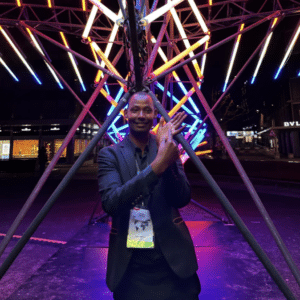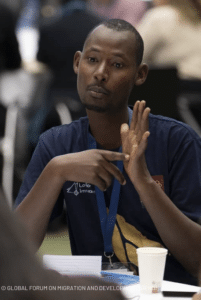Editor: Tonny Mulenzi (Learning and Documentation Officer at Light for World based in Uganda; Disability-Inclusive Youth Researcher; Team Lead Love for Immigrants; Peace Fellow at Refugee Law Project, Migration Youth Forum & GFMD Delegate 2024)
The peer-to-peer approach has the potential to break disability inclusion barriers by fostering mutual understanding, empathy, and support among individuals with and without disabilities. Through this approach, individuals can learn from each other’s experiences, share knowledge and skills, and collaborate to address common challenges. Peer support networks can provide practical assistance, emotional support, and encouragement, empowering people with disabilities to participate more fully in society. By promoting inclusivity and equality, the peer-to-peer approach contributes to creating a more accessible and accommodating environment for individuals with disabilities to thrive for instance many organizations out there would love to employ people living with disabilities; however, their fear is the extra cost incurred in hiring sign language interpreters, caretakers, guides. It’s like one person will be taking the salary for two people. That’s why the peer-to-peer approach can be the game-changer.
In 2023, we embarked on the Disability Inclusive Youth Research Program, a co-creative research collaboration implemented with the Child Health and Development Centre of Makerere University, the National Council for Persons with Disabilities, and THRU Zim Health Unit. The Disability Inclusive Youth program aims to develop and implement youth-led African disability research, create employment opportunities for disabled youth in research, and encourage and facilitate youth-led knowledge sharing and awareness raising,youth with Disabilities, together with their peers, receive job mentorship and hands-on experience from mentors working on existing research programs. I, together with my peer (Rebecca), were placed at Makerere University Child Health and Development Center, along with another youth researcher with Visual impairment and his peer. We all went through the same training on research.
Our internship place was busy working on a Parenting program which they quickly adopted to us and eventually gave birth to Disability Inclusive Parenting program, a research study aimed at adapting and piloting a Disabilities Inclusive Parenting Programme,the project addresses policy gaps, adapts the successful Parenting for Respectability Programme for parents with disabilities, and focuses on policy analysis, program adaptation, stakeholder acceptance, program impact, and the urgent need to support the estimated 2.5 million children with disabilities in Uganda, aiming to inform policy revisions and enhance parenting support systems. Our presence made the team realize the importance of including the Disability aspect in their program. This is a great indicator of why researchers, policymakers, civil society, and the private sector need to include youth with disabilities in research and their projects since youth with disabilities have firsthand experience and can drive meaningful contributions if included. There is nothing about us without us. One another note,Sign language interpreters, caretakers, and guides are invaluable members of the team and should be treated with the same respect and inclusion as fellow staff, recognizing their essential contributions and empowering them to feel valued and integral to the work. Rather than mere service providers, they are vital partners in facilitating accessibility, support, and success.

Four months ago, I had the privilege of attending the Global Forum on Migration & Development in Geneva, Switzerland through the Migration Youth and Children Platform. I was deeply encouraged by the positive interactions with a few civil society organizations and government representatives. In private conversations I had with them, they affirmed that it was their first time witnessing a significant improvement in the inclusion of persons with disabilities at the GFMD. They were delighted to learn that the Migration Youth and Children Platform had allocated a slot to me, together with my sign language interpreter. Most importantly, they appreciated my emphasis on and continuous advocacy for the need to prioritize disability inclusion strategies in their operations.
As a team lead for Love 4 Immigrants, a social space for immigrant support aiming to connect immigrants to their communities as respected, loved, and heard individuals by sharing their narratives through art, storytelling, and sign language, we envision a world where all stories depict immigrants with dignity and respect, where their added value is acknowledged, and where acceptance reigns over discrimination, the problem we wish to solve is how these negative depictions have impacted immigrants’ lives and their collective sense of self-worth and belonging. What we care most about is how those narratives are affecting immigrants, how these negative perceptions are being internalized by immigrants, their children, and those with similar experiences. It is concerning that these internalized ideologies are based on prejudice that affects not only the external world but also the interior world. Many immigrants feel empowered to tell their own story through a variety of creative mediums, but there are not enough platforms where immigrants are welcomed to tell their stories.
When it comes to intersectionality for migration and disability, there is still a big gap to tackle. Most organizations of persons with disabilities have done a great job impacting meaningful disability inclusion in our society; however, their biggest emphasis is placed on their home countries. More efforts are needed to push these energies beyond borders. We want to see people with disabilities thrive beyond borders, ensuring disability benefits reach even those who are migrants. Job offers on international levels can also favor us. Security personnel and those serving migrants need to undertake basic sign language training and disability inclusion awareness during their training to bridge the communication gap and overcome stereotypes that arise from not knowing the Deaf culture. There is a need to amplify the mobility of people with disabilities beyond borders amidst our unwelcoming system that is exclusionary, leaving out migrants and refugees with disabilities.
By giving them platforms to participate in decision-making, it has always been my desire to see people with disabilities who survived insurgencies, wars, and armed conflicts given a platform to share their stories of survival. It may enrich us with new perspectives and a great approach to tackling many global issues related to migrations. Persons with disabilities are disproportionately affected in migration and forced displacement situations, with older migrants and women and girls with disabilities being particularly vulnerable. The migration process can create or worsen disabilities, but data on disability is limited due to non-standardized collection methods and varying definitions of disability across countries and organizations. Estimates suggest that 12 million people in the forced displacement population have disabilities (GMDAC analysis based on UNCHR 2020 and WHO 2011).
Existing data sources provide fragmented information at national or local levels, or on specific groups. Significant data gaps persist, including a lack of available or timely data, harmonized datasets, and standardized collection methods. Addressing these gaps is crucial to gain a comprehensive understanding of human mobility and disability, informing policy making and program implementation, and tracking related Sustainable Development Goals. Standardized data collection and a unified definition of disability are essential to fill these knowledge gaps and support inclusive responses to migration and forced displacement. (Reference: GMDAC analysis based on UNCHR 2020 and WHO 2011) My appreciation to everyone who is doing their best to create a more loving, creative, and compassionate world. You are great heroes, and keep doing good to others.



